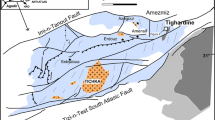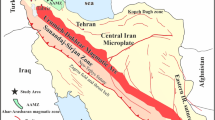Abstract
Plutonic rocks associated with the Latir volcanic field comprise three groups: 1) ∼25 Ma high-level resurgent plutons composed of monzogranite and silicic metaluminous and peralkaline granite, 2) 23–25 Ma syenogranite, and alkali-feldspar granite intrusions emplaced along the southern caldera margin, and 3) 19–23 Ma granodiorite and granite plutons emplaced south of the caldera. Major-element compositions of both extrusive and intrusive suites in the Latir field are broadly similar; both suites include high-SiO2 rocks with low Ba and Sr, and high Rb, Nb, Th, and U contents. Moreover, both intermediateto siliciccomposition volcanic and plutonic rocks contain abundant accessory sphene and apatite, rich in rare-earth elements (REE), as well as phases in which REE's are essential components. Strong depletion in Y and REE contents, with increasing SiO2 content, in the plutonic rocks indicate a major role for accessory mineral fractionation that is not observed in volcanic rocks of equivalent composition. Considerations of the rheology of granitic magma suggest that accessory-mineral fractionation may occur primarily by filter-pressing evolved magmas from crystal-rich melts. More limited accessory-mineral crystallization and fractionation during evolution of the volcanic magmas may have resulted from markedly lower diffusivities of essential trace elements than major elements. Accessory-mineral fractionation probably becomes most significant at high crystallinities. The contrast in crystallization environments postulated for the extrusive and intrusive rocks may be common to other magmatic systems; the effects are particularly pronounced in highly evolved rocks of the Latir field. High-SiO2 peralkaline porphyry emplaced during resurgence of the Questa caldera represents non-erupted portions of the magma that produced the Amalia Tuff during caldera-forming eruption. The peralkaline porphyry continues compositional and mineralogical trends found in the tuff. Amphibole, mica, and sphene compositions suggest that the peralkaline magma evolved from metaluminous magma. Extensive feldspar fractionation occurred during evolution of the peralkaline magmas, but additional alkali and iron enrichment was likely a result of high halogen fluxes from crystallizing plutons and basaltic magmas at depth.
Similar content being viewed by others
References
Bacon CR, Druitt TH (1988) Compositional evolution of the zoned calcalkaline magma chamber of Mount Mazama, Crater Lake, Oregon. Contrib Mineral Petrol 98:224–256
Bailey DK (1969) The stability of acmite in the presence of H2O. Am J Sci 267-A:1–16
Bailey DK (1974a) Experimental petrology relating to oversaturated peralkaline volcanics: a review. Bull Volcanol 38:637–652
Bailey DK (1974b) Origin of alkaline magmas as a result of anatexis. Melting in the deep crust. In: Sorensen H (ed) The alkaline rocks. Wiley, London, pp 436–441
Bailey DK (1980) Volcanism, Earth degassing and replenished lithospheric mantle. Phil Trans R Soc London A297:309–322
Bailey DK, Macdonald R (1975) Fluorine and chlorine in peralkaline liquids and the need for magma generation in an open system. Min Mag 40:405–414
Chappell BW, White AJR, Wyborn D (1987) The importance of residual material (restite) in granite petrogenesis. J Petrol 28:1111–1138
Cordell L, Long CL, Jones DW (1986) Geophysical expression of the batholith beneath Questa Caldera, New Mexico. J Geophys Res 90:11263–11274
Czamanske GK, Dillet B (1988) Alkali amphibole, tetrasilicic mica, and sodic pyroxene in peralkaline siliceous rocks, Questa caldera, New Mexico. Am J Sci 288-A: 358–392
Davies GR, Macdonald R (1987) Crustal influences in the petrogenesis of the Naivasha basalt-comendite complex: combined trace element and Sr-Nd-Pb isotope constraints. J Petrol 28:1009–1031
Dillet B, Czamanske GK (1987) Aspects of the petrology, mineralogy, and geochemistry of the granitic rocks associated with Questa caldera, northern New Mexico. US Geol Surv OpenFile Rep 87-258 p 238
Fourcade S, Allegre CJ (1981) Trace element behavior in granite genesis: a case study of the calc-alkaline plutonic association from the Querigut complex (Pyrenees, France). Contrib Mineral Petrol 76:177–195
Hagstrum JT, Johnson CM (1986) A paleomagnetic and stable isotope study of the pluton at Rio Hondo near Questa, New Mexico: implications for C.R.M. related to hydrothermal alteration. Earth Planet Sci Lett 78:296–314
Hagstrum JT, Lipman PW (1986) Paleomagnetism of the structurally deformed Latir volcanic field, northern New Mexico: relations to formation of the Questa caldera and development of the Rio Grande rift. J Geophys Res 91:7383–7402
Harrison TM, Watson EB (1983) Kinetics of zircon dissolution and zirconium diffusion in granitic melts of variable water content. Contrib Mineral Petrol 84:66–72
Harrison TM, Watson EB (1984) The behavior of apatite during crustal anatexis: equilibrium and kinetic considerations. Geochim Cosmochim Acta 48:1467–1477
Haskin LA, Haskin MA, Frey FA, Wildeman (1968) Relative and absolute terrestrial abundances of the rare earths. In: Ahrens LH (ed) Origin and distribution of the elements. Pergamon Press, Oxford, pp 889–912
Hofmann AW (1980) Diffusion in natural silicate melts: a critical review. In: Hargraves RB (ed) Physics of Magmatic Processes, Princeton University Press, Princeton, pp 385–417
Irvine TN (1980) Magmatic infiltration metasomatism, double-diffusive fractional crystallization, and adcumulus growth in the Muskox intrusion and other layered intrusions. In: Hargraves RB (ed) Physics of magmatic processes. Princeton University Press, Princeton, pp 325–384
Johnson CM (1986) The Questa magmatic system: petrologic, chemical and isotopic variations in cogenetic volcanic and plutonic rocks of the Latir volcanic field and associated intrusives, northern New Mexico. PhD thesis, Stanford University, p 322
Johnson CM, Lipman PW (1988) Origin of metaluminous and alkaline volcanic rocks of the Latir volcanic field, northern Rio Grande rift, New Mexico. Contrib Mineral Petrol 100:107–128
Johnson CM, Lipman PW, Czamanske GK (1989) H, O, Sr, Nd, and Pb isotope geochemistry of the Latir volcanic field and cogenetic intrusions, New Mexico, and relations between evolution of a continental magmatic center and modifications of the lithosphere. Contrib Mineral Petrol (in press)
Jones DM, Norris JR (1984) Geology of the South Fork molybdenum occurrence, Taos County, New Mexico. New Mex Geol Soc 35th Field Confer, pp 213–218
Laughlin AW, Rehrig WA, Mauger RL (1969) K-Ar chronology and sulphur and strontium isotope ratios at the Questa mine, New Mexico. Econ Geol 64:903–909
Leeman WP, Phelps DW (1981) Partitioning of rare earths and other trace elements between sanidine and coexisting volcanic glass. J Geophys Res 86:10193–10199
Leonardson RW, Dunlap G, Starquist VL, Bratton GP, Meyer JW, Osborn LW, Atkin SA, Molling PA, Moore RF, Olmore SD (1983) Preliminary geology and molybdenum deposits at Questa, New Mexico. In: The genesis of Rocky Mountain ore deposits: changes with time and tectonics. Proc Denver Region Explor Geol Soc Symp, pp 151–155
Lipman PW (1983) The Miocene Questa caldera, northern New Mexico: relation to batholith emplacement and associated molybdenum mineralization. In: The genesis of Rocky Mountain ore deposits: changes with time and tectonics. Proc Denver Region Explor Geol Soc Symp, pp 133–147
Lipman PW (1987) Rare-earth-element compositions of Cenozoic volcanic rocks in the southern Rocky Mountains and adjacent areas. US Geol Surv Bull 1668, p 23
Lipman PW (1988) Evolution of silicic magma in the upper crust: the mid-Tertiary Latir volcanic field and its cogenetic granitic batholith, northern New Mexico, USA. Trans Royal Soc Edinburg. Earth Sci 79:265–288
Lipman PW, Reed JC Jr (1989) Geologic map of the Latir volcanic field and adjacent areas, northern New Mexico. US Geol Surv Misc Invest Map 1-1907
Lipman PW, Mehnert HH, Naeser CW (1986) Evolution of the Latir volcanic field, northern New Mexico and its relation to the Rio Grande rift, as indicated by K-Ar and fission-track dating. J Geophys Res 91: 6329–6346
Ludington S (1981) Quartz-pyrite-molybdenite stockwork near South Fork Peak, Taos County, New Mexico. US Geol Surv Open-File Rep 81–180, p 8
Macdonald R (1974) The role of fractional crystallization in the formation of alkaline rocks. In: Sorensen H (ed) The alkaline rocks. Wiley, London, pp 442–458
Macdonald R, Davis GR, Bliss CM, Leat PT, Bailey DK, Smith RL (1987) Geochemistry of high-silica peralkaline rhyolites, Naivasha, Kenya Rift Valley. J Petrol 28:979–1008
Mahood GA (1981) Chemical evolution of a Pleistocene rhyolite center; Sierra La Primavera, Jalisco, Mexico. Contrib Mineral Petrol 77:129–149
Mahood G, Hildreth W (1983) Large partition coefficients for trace elements in high-silica rhyolites. Geochim Cosmochim Acta 47:11–30
Martin D, Griffiths RW, Campbell IH (1987) Compositional and thermal convection in magma chambers. Contrib Mineral Petrol 96:465–475
Masuda AW, Nakamura H, Tanaka T (1973) Fine structure of mutually normalized rare-earth patterns of chondrites. Geochim Cosmochim Acta 37:239–248
McBirney AR, Murase T (1984) Rheological properties of magmas. Ann Rev Earth Planet Sci 12:337–357
McCarthy TS, Hasty RA (1976) Trace element distribution patterns and their relationship to the crystallization of granitic melts. Geochim Cosmochim Acta 40:1351–1358
McKenzie D (1985) The extraction of magma from the crust and mantle. Earth Planet Sci Lett 74:81–91
Mittlefehldt DW, Miller CF (1983) Geochemistry of the Sweetwater Wash pluton, California: implications for “anomalous” trace element behavior during differentiation of felsic magmas. Geochim Cosmochim Acta 47:109–124
Nash WP, Crecraft HR (1985) Partition coefficients for trace elements in silicic magmas. Geochim Cosmochim Acta 49:2309–2322
Noyes HJ, Frey FA, Wones DR (1983) A tale of two plutons: geochemical evidence bearing on the origin and differentiation of the Red Lake and Eagle Peak plutons, central Sierra Nevada, California. J Geol 91:487–509
Robert JL, Maury RC (1979) Natural occurrence of a (Fe, Mn, Mg) tetrasilicic potassium mica. Contrib Mineral Petrol 68:117–123
Ryerson FJ, Hess PC (1978) Implications of liquid-liquid distribution coefficients to mineral-liquid partitioning. Geochim Cosmochim Acta 42:921–932
Sawka WN (1988) REE and trace element variations in accessory minerals and hornblende from the strongly zoned McMurry Meadows pluton, California. Trans Royal Soc Edinburg. Earth Sci 79:157–168
Simmons EC, Hedge CE (1978) Minor-element and Sr-isotope geochemistry of Tertiary stocks, Colorado Mineral Belt. Contrib Mineral Petrol 67:379–396
Steven TA (1975) Middle Tertiary volcanic field in the southern Rocky Mountains. Geol Soc Am Mem 144:75–94
Steven TA, Luedke RG, Lipman PW (1974) Relation of mineralization to calderas in the San Juan volcanic field, southwestern Colorado. US Geol Surv Res 2:405–409
Stormer JC Jr, Nichols J (1978) XLFRAC: a program for the interactive testing of magmatic differentiation models. Comput Geosci 4:143–159
Streckeisen A (1976) To each plutonic rock its proper name. Earth Sci Rev 12:1–33
Tait SR, Huppert HE, Sparks RSJ (1984) The role of compositional convection in the formation of adcumulate rocks. Lithos 17:139–146
Thompson RA, Dungan MA, Lipman PW (1986) Multiple differentiation processes in early-rift calc-alkaline volcanics, northern Rio Grande rift, New Mexico. J Geophys Res 91:6046–6058
van der Molen I, Paterson MS (1979) Experimental deformation of partially-melted granite. Contrib Mineral Petrol 70:299–318
Watson EB (1976) Two-liquid partition coefficients: experimental data and geochemical implications. Contrib Mineral Petrol 56:119–134
Webster JD, Holloway JR (1988) Experimental constraints on the partitioning of Cl between topaz rhyolite melt and H2O and H2O+CO2 fluids: new implications for granitic differentiation and ore deposition. Geochim Cosmochim Acta 52:2091–2105
Wolff JA, Storey M (1984) Zoning in highly alkaline magma bodies. Geol Mag 121:563–575
Author information
Authors and Affiliations
Rights and permissions
About this article
Cite this article
Johnson, C.M., Czamanske, G.K. & Lipman, P.W. Geochemistry of intrusive rocks associated with the Latir volcanic field, New Mexico, and contrasts between evolution of plutonic and volcanic rocks. Contr. Mineral. and Petrol. 103, 90–109 (1989). https://doi.org/10.1007/BF00371367
Received:
Accepted:
Issue Date:
DOI: https://doi.org/10.1007/BF00371367




